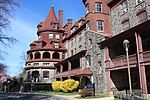Bryn Mawr Summer School for Women Workers in Industry

The Bryn Mawr Summer School for Women Workers in Industry (1921–1938) was a residential summer school program that brought approximately 100 young working women—mostly factory workers with minimal education—to the Bryn Mawr College campus, in Bryn Mawr, Pennsylvania, each year for eight weeks of liberal arts study. As part of the workers' education movement of the 1920s and 30s, the experimental program was unique in several ways. It was the first program of its kind for women in the United States; it was conceived, directed, and largely taught by women; and it was hosted by a women's college. Originally the brainchild of Bryn Mawr president M. Carey Thomas, the program was funded by philanthropists such as John D. Rockefeller Jr. and taught by distinguished faculty drawn from local institutions. Under the direction of Hilda Worthington Smith it evolved into a successful workers' education program that served as the model for several others. Many of the students, who came from diverse ethnic and religious backgrounds and worked in a variety of industries, went on to become union leaders. For political reasons, the program fell out of favor with the college board of trustees and was terminated in 1938. The school is the subject of a 1985 documentary by Suzanne Bauman and Rita Heller, The Women of Summer.
Excerpt from the Wikipedia article Bryn Mawr Summer School for Women Workers in Industry (License: CC BY-SA 3.0, Authors, Images).Bryn Mawr Summer School for Women Workers in Industry
Airdale Road, Lower Merion Township
Geographical coordinates (GPS) Address Nearby Places Show on map
Geographical coordinates (GPS)
| Latitude | Longitude |
|---|---|
| N 40.02405 ° | E -75.31397 ° |
Address
Bryn Mawr College
Airdale Road
19010 Lower Merion Township
Pennsylvania, United States
Open on Google Maps






